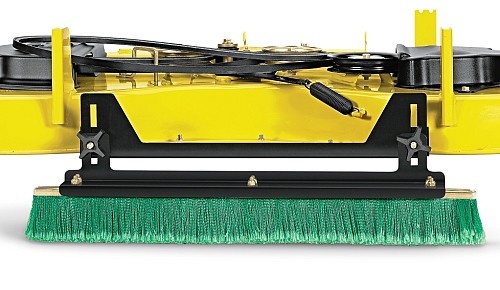How To Mow Stripes In Your Lawn
 Everyone wants a good-looking lawn: tall, lush, green, and even. But some homeowners want to be better than good; they’d like a lawn that stands out. That’s why lawn striping – a technique borrowed from ballparks and golf courses -- is hot right now.
Everyone wants a good-looking lawn: tall, lush, green, and even. But some homeowners want to be better than good; they’d like a lawn that stands out. That’s why lawn striping – a technique borrowed from ballparks and golf courses -- is hot right now.
Find out what the buzz is about and how to mow stripes in your lawn, in this discussion with Mark Waldvogel, Product Manager at John Deere.
- Explain how to mow stripes in your lawn.
The stripes or other patterns are not actually mown in. Instead, you mechanically flatten sections of your lawn, creating an optical illusion. The way light hits the grass makes grass pointed toward you appear darker than if it’s pointed away. The more you flatten the grass in a particular direction, the more pronounced the contrast.
- Do you need a certain type of mower or equipment?
You won’t need a special mower, but I’d recommend a striping attachment, or “kit.” These are available for walking mowers, Z-type (zero-turn) mowers, or lawn tractors.
- Is any special skill set required?
The essential skill is being able to drive halfway straight. For some folks that’s more challenging than others. You also need to know the right way to turn around, raising the mower deck or attachment at the end of each row.
- Does the technique work on all species of grass?
It’s better on cool-season Northern grasses, which are typically taller and thinner. Southern grasses grow more horizontal than vertical, don’t get as tall, and are stiffer and thicker. Result: they don’t flatten very well.
- What types of patterns can you make?
Commonest is the back-and-forth parallel striped pattern. Mow with lines in both dimensions to form a checkerboard. On lawns that aren’t square, follow the shape of your yard with arc-shaped stripes.
I’ve heard of folks mowing messages or team logos on their property. That takes artistic talent and/or GPS-enabled driving instructions.
- Is lawn striping more work than regular mowing?
To keep the pattern, you’ll have to redo it every time. However, striping takes just a little longer than conventional mowing. And it’s not something you’re super committed to if you change your mind.
- Compare types of lawn striping kit.
Grass Groomer -- John Deere’s trademark lawn striping attachment -- resembles a stiff-bristled broom that you mount on back of the mower, using 2 thumbscrews. One advantage is the broom spreads clumps and makes the cut grass evener, helping prevent dead spots. It also slides nicely, even over rough or uneven ground (say, your property was not leveled well or gophers are digging mounds).
Other striping kits involve plastic or metal rollers, so they have that “golf course” aura (although golf courses use a heavy, water-filled metal roller, often trailer-mounted). But rollers are bad at turns on residential properties. Put one on a Z-type mower, and it’s literally going sideways ... hard on the roller and the grass!
There are also mowers on the market which are set up to stripe 100 percent of the time. They do a good job striping, but with one limitation; you may not want to be striping a pasture or other, less visible parts of your property. In contrast, a lawn striping kit can be mounted or removed as your needs change.

How to mow stripes in your lawn: pro tips
- Have a visual direction to follow.
- Pay close attention to vehicle deck width and lawn layout. Allow for overlap.
- Be especially careful striping a small yard. The smaller the canvas, the higher the bar to make it perfect.
- Adjust the brush to ensure it’s in contact with the ground, whatever your cut height.
General lawn care tips
- Mow frequently for a healthier, drought-resistant lawn.
- Never take more than 1/3 of the plant. Yes, you might be mowing several times a week in spring, when it’s raining heavily and the grass is really growing -- especially if you’ve added a little too much fertilizer! Ed: If that’s not compatible with your work schedule (and your life), find a good landscaper.
- Mulch. Don’t haul that organic matter away, return it to the soil to nourish your grass.

Laura Firszt writes for networx.com.
Looking for a Pro? Call us (866) 441-6648

Landscaping Average Costs
Landscapers Experiences

Lawn Repair: Contractor Followup To My DIY Prep Got The Job Done

Landscaping Turns A Weed Patch Into A Great Little Zen Garden



